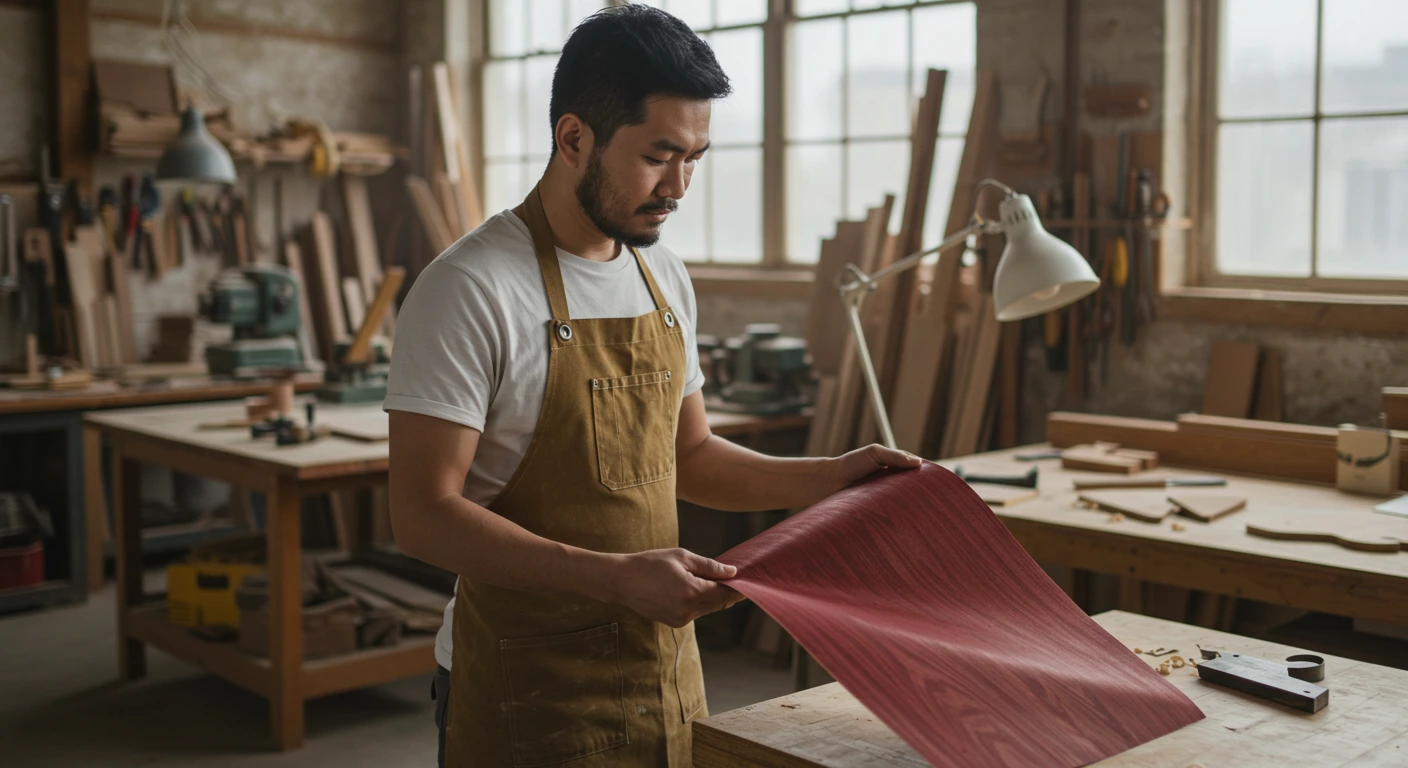
Eco-Friendly Choice
Veneer wood is an eco-friendly option that promotes sustainability. Since it uses thin slices of timber rather than solid wood, it allows designers to use exotic and rare wood species without depleting forests. This means you can enjoy the beauty of wood while contributing to environmental conservation. By choosing veneer, you’re supporting responsible forestry practices.
Cost-Effective Solution
One of the most significant advantages of veneer wood is its cost-effectiveness. Solid wood can be expensive, especially when using high-quality species. In contrast, veneer wood provides the look and feel of solid wood at a fraction of the cost. This affordability enables designers and homeowners to create stunning furniture pieces without breaking the bank.
Design Flexibility
Veneer wood offers unparalleled design flexibility. It can be applied to various shapes and surfaces, allowing for creative and modern furniture designs. Whether you want a smooth finish or intricate patterns, veneer can adapt to your vision. You can even mix different wood types for unique and personalized designs, making each piece stand out.
Lightweight and Easy to Work With
Veneer wood is lighter than solid wood, making it easier to handle during the design and construction process. This lightweight nature allows for more ambitious designs that might be impractical with solid wood. You can create larger pieces such as tables and cabinets without worrying about excessive weight.
Quality Finishes
Applying veneer wood allows for a finishing touch that enhances visual appeal. Veneers come in various wood grains, colors, and patterns, which means you can choose the ideal look for your furniture. They can also be easily stained or painted, offering even more options to coordinate with your interior design. Additionally, the fine surface of veneer wood makes it easier to apply high-quality finishes that can protect the wood from scratches, water damage, and UV rays.
Minimized Warping and Shrinking
Solid wood can be prone to warping, cracking, or shrinking over time due to environmental changes. Veneer wood, however, is less susceptible to these issues. The thin layers of veneer help maintain stability, reducing the risk of these common problems and ensuring your furniture remains beautiful for years to come. This stability is a major benefit for furniture makers and homeowners looking for longevity in their pieces.
Varieties of Veneer Wood
| Wood Type | Appearance | Benefits |
|---|---|---|
| Cherry | Warm, reddish-brown hue | Beautiful aging process, highly valued |
| Walnut | Rich, dark color with striking grain | Durable and strong, timeless appeal |
| Oak | Light to medium brown with pronounced grain | Sturdy and versatile, great for various styles |
| Maple | Light color with fine grain | Ideal for modern furniture, highly durable |
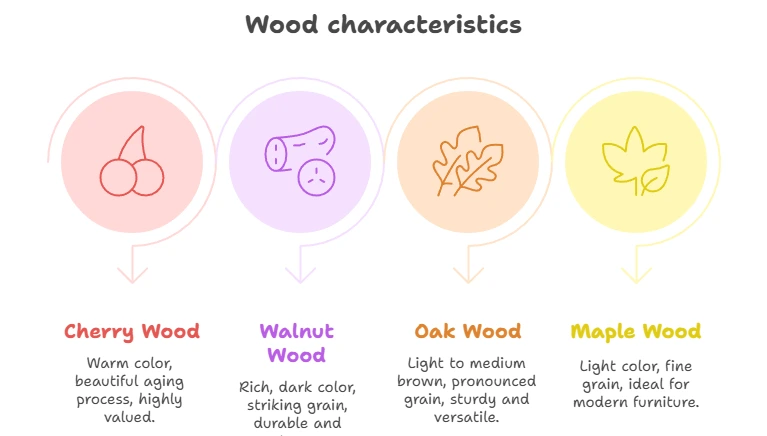
Veneer wood into furniture design offers numerous benefits, such as sustainability, cost-effectiveness, and design versatility. Whether you’re a designer or a DIY enthusiast, it’s a great option for creating stunning furniture that stands out without straining your budget. For those looking to explore more about veneer wood and its applications, you might find excellent resources at Wood Magazine or Woodworkers Source.
Comparing Veneer Wood to Solid Wood: What You Need to Know
Choosing between veneer wood and solid wood can be a vital decision when it comes to your home or furniture projects. Understanding the differences can help you make a more informed choice that aligns with your aesthetic desires and budget.
Veneer wood is made by slicing thin layers of wood from a log. These slices, or “veneers,” are then glued onto core panels, typically made of plywood or MDF (medium-density fiberboard). This process creates a product that offers the beauty of real wood while often being more cost-effective and environmentally friendly. Solid wood, on the other hand, is made from a single piece of wood and offers unmatched durability and strength.
Cost Considerations
When comparing veneer wood to solid wood, budget is often a major factor. Here’s a quick breakdown:
- Veneer Wood: Generally less expensive due to the thinner layers and less material used.
- Solid Wood: Typically costs more because it’s made from whole pieces of lumber.
If you’re looking to save some money, veneer wood can offer the look of luxury without the hefty price tag.
Durability and Lifespan
Another critical factor is durability. Here’s how these two options stack up:
| Aspect | Veneer Wood | Solid Wood |
|---|---|---|
| Durability | Less durable; can chip or peel if not treated properly. | Highly durable; can last decades with proper care. |
| Lifespan | Shorter lifespan; generally around 10–20 years depending on care. | Long-lasting; can remain functional and beautiful for generations. |
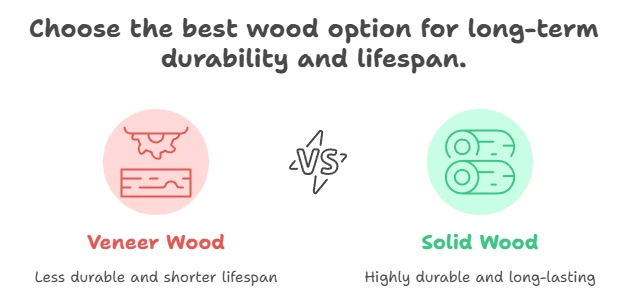
Opting for solid wood may be more suitable for essential furniture that you plan to use heavily, while veneer can be an excellent choice for decorative pieces that won’t face heavy wear and tear.
Environmental Impact
Both materials have environmental implications, but they differ significantly:
- Veneer Wood: More sustainable as it uses less wood overall. Slicing thin veneers means fewer trees are required to create a similar aesthetic effect.
- Solid Wood: Requires entire trees, which may lead to deforestation if not sourced sustainably.
If eco-friendliness is a concern for you, consider choosing veneer wood for its lower ecological footprint. Check out sources like FSC for responsibly sourced wood products.
Appearance and Aesthetics
The visual aspect of your choice should also be weighed, particularly if you’re focused on style:
- Veneer Wood: Can effectively replicate the appearance of expensive woods, making it versatile for various design styles.
- Solid Wood: Offers a unique grain pattern and will often age beautifully, gaining character over time.
Both options can enrich your surroundings. However, if a rich, natural feel is your goal, solid wood may take the lead.
Maintenance Requirements
Maintaining your furniture can affect the longevity and performance of both materials:
- Veneer Wood: Requires gentle cleaning; harsh conditions can lead to damage.
- Solid Wood: While it can withstand more wear, it still needs regular oiling and care.
Depending on your lifestyle and how much time you can dedicate to maintenance, your choice of material should reflect that.
Choosing between veneer wood and solid wood involves various considerations: budget, durability, environmental impact, aesthetics, and maintenance. You’ll want to think carefully about how you plan to use the material in your projects. For further details and to explore quality options, visit specialized sites like Woodworkers Source and Wood Magazine. Remember, your choice ultimately depends on your personal needs and values. Whether you opt for veneer wood’s affordability or solid wood’s authenticity, each has its unique features that cater to different preferences.
How to Properly Care for and Maintain Veneer Wood Surfaces
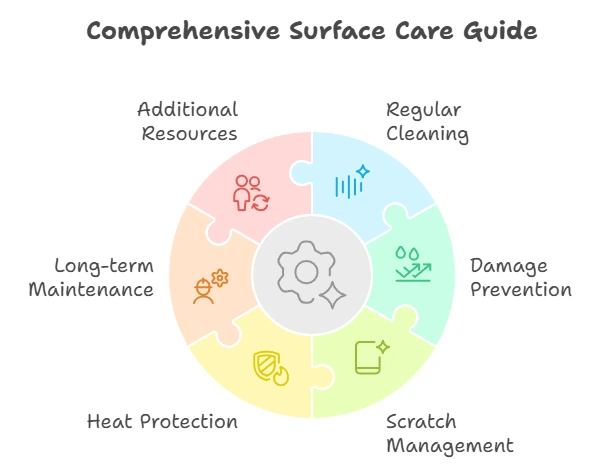
Veneer wood surfaces can add a touch of elegance and style to your home or office. However, they require proper care and maintenance to ensure they remain beautiful over time. Here are some effective strategies to keep your veneer wood surfaces looking their best.
Regular Cleaning
Keeping your veneer wood clean is essential for its longevity. Dust and grime can accumulate and dull the finish. Here’s how to clean it:
- Use a Soft Cloth: Opt for a microfiber cloth to avoid scratching the surface.
- Avoid Harsh Chemicals: Cleaners with ammonia or bleach can damage the veneer. Instead, use a mild soap solution.
- Dry Thoroughly: After cleaning, ensure the surface is dried properly to avoid moisture damage.
Preventing Damage
Like any wooden surface, veneer can be vulnerable to damage. Here are some tips to prevent issues:
- Use Coasters: Place coasters under drinks to prevent rings and moisture damage.
- Avoid Direct Sunlight: Excessive sunlight can fade the veneer. Use curtains or blinds to protect it.
- Maintain Humidity: Wood expands and contracts. Keeping your home’s humidity level between 40-60% can help avoid cracks.
Dealing with Scratches
Scratches can be unsightly, but they can often be repaired. Tackling scratches early is key:
- Wax Sticks: For light scratches, using a wax stick that matches the veneer color can fill in the scratch.
- Wood Filler: For deeper scratches, consider using a wood filler, applying it carefully, then sanding it smooth.
- A Good Polish: After repairs, applying a quality wood polish can help blend the area, restoring its shine.
Protecting from Heat
Heat can cause significant damage to veneer wood surfaces. To protect them, be mindful of the following:
- Use a Heat Shield: Always place hot items on a trivet or heat shield.
- Avoid Heating Devices: Items like hair dryers or space heaters should be kept away from the surfaces.
Long-term Maintenance
For the best long-term care, consider these additional steps:
- Annual Polishing: Use a quality furniture polish once a year to maintain the sheen.
- Professional Refinishing: If the surface becomes too dull or worn, consider hiring a professional to refinish it.
- Check for Water Damage: Inspect regularly for any signs of water damage, especially in humid areas like kitchens or bathrooms.
Additional Resources
For more in-depth information about the best practices in taking care of veneer wood, consider checking out these resources:
Investing time and effort in the proper care of your veneer wood surfaces can ensure they remain stunning for years to come. Whether it’s a desk, table, or cabinetry, these surfaces can always be a topic of admiration if maintained correctly. Simple practices such as regular cleaning, avoiding direct sunlight, and using coasters can go a long way in preserving their beauty.
By adhering to these guidelines, you will not only enhance the appearance of your veneer wood but also extend its life, making it a worthy addition to your space.
Innovative Applications of Veneer Wood in Modern Architecture
Veneer wood has significantly transformed modern architecture, offering a unique blend of aesthetics and functionality. Architects and designers increasingly utilize veneer not just for its visual appeal but also for its sustainable properties. This thin layer of wood allows for a wide range of innovative applications, enhancing both interior and exterior spaces.
One of the most popular uses of veneer wood is in wall cladding. By applying veneer to walls, architects can create striking visual effects while enjoying the benefits of using less solid wood. This sustainable approach helps conserve forest resources while making spaces feel warm and inviting. For instance, you can create a stunning accent wall using a variety of timber species, including oak, walnut, and maple.
Moreover, veneer wood is also a smart choice for cabinetry and furniture. The lightweight nature of veneer makes it easier to work with, allowing for versatile designs that can adapt to different needs. Imagine a sleek kitchen with beautifully veneered cabinets that offer both style and storage. The clean finish of veneer wood provides an elegant look without the added weight and cost of solid wood.
Another fascinating application of veneer wood is in ceiling treatments. More architects are using it to create captivating ceiling designs that draw the eye upwards. This method not only introduces a touch of sophistication but also helps in sound insulation, enhancing the acoustics of various spaces like theaters and conference rooms.
When it comes to flooring, veneered options are gaining popularity. Engineered wood veneers provide a durable yet attractive foundation for homes and commercial spaces. They are less prone to warping and are available in various finishes, enabling you to choose what best suits your decor. Speedy installation and lower maintenance requirements further make them a favorite among builders.
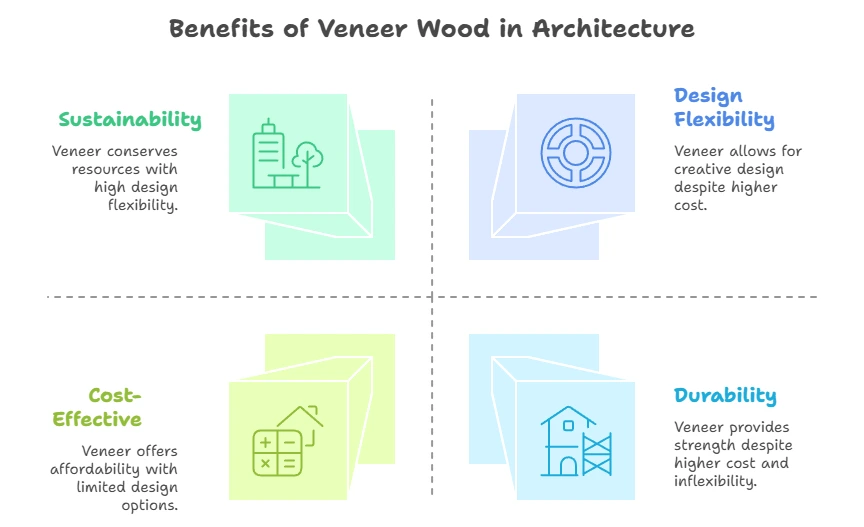
Let’s look at some key benefits of using veneer wood in modern architecture:
- Cost-Effective: Veneer wood is more affordable than solid wood, making it an accessible option for both residential and commercial projects.
- Sustainability: Using veneer conserves natural resources, allowing architects to build eco-friendly structures.
- Design Flexibility: Veneer can be applied to various surfaces, allowing for creativity in design.
- Lightweight: The reduced weight of veneer wood makes construction easier and more cost-efficient.
- Durability: While thin, veneer wood is surprisingly strong and resilient when properly maintained.
Additionally, veneers are often used in acoustic panels. These panels help control sound within large spaces, making them essential in venues like auditoriums and conference halls. By using veneer wood for these applications, you can combine functionality with style.
As technology advances, new methods of creating and applying veneer are emerging. Innovations like digital printing on veneers allow for customized designs, enabling architects to achieve unique looks that were previously impossible. You can have the natural beauty of wood while also branding spaces with logos or designs that reflect specific themes—such as in offices or commercial establishments.
With the many innovative applications of veneer wood, it’s evident that it plays a crucial role in modern architecture. Whether you’re considering a renovation or building from scratch, think about how veneer wood can elevate your design. Explore resources like Wood Magazine for more information about varnishing and finishing techniques, or visit Woodworker’s Source for tips on the use of veneer in woodworking projects.
The innovative use of veneer wood in architecture is set to continue. As sustainability becomes a priority, and as design requirements evolve, veneer will prove to be a versatile and practical choice. With the balance of beauty and practicality, there’s little doubt that veneer wood will remain a favored material in modern architectural practices.
The Environmental Impact of Veneer Wood Production and Usage
Veneer wood is a popular choice in many industries due to its aesthetic appeal and versatility. However, as consumer demand grows, understanding the environmental impact of veneer wood production and usage is essential for both manufacturers and consumers. This knowledge allows for more informed decisions that favor sustainability.
The production of veneer wood primarily involves slicing thin sheets from a log of lumber. This method maximizes the utility of the wood, allowing manufacturers to use less raw material than solid wood furniture would require. Although this process can reduce waste, it is important to recognize that veneer wood still contributes to deforestation when sourced unsustainably. Sustainable harvesting practices aim to minimize this impact by ensuring that forests are managed responsibly, allowing trees to regenerate naturally.
Eco-Friendly Practices in Veneer Wood Production
To mitigate the environmental effects of veneer wood production, several eco-friendly practices are being adopted:
- Sustainable Forestry: Certified sources such as the Forest Stewardship Council (FSC) ensure that wood is harvested sustainably.
- Regeneration: Practices that promote the growth of trees after harvesting can help maintain ecological balance.
- Waste Utilization: Offcuts and remnants from the veneer process can be used for products like MDF or biomass fuels, reducing overall waste.
While these practices help lessen the environmental burden, the type of wood used also plays a crucial role. Some trees have longer growth cycles, making them less sustainable compared to faster-growing species such as birch and poplar.
The Carbon Footprint of Veneer Wood
When discussing the environmental impact, it’s vital to consider the carbon footprint associated with veneer wood. Producing veneer can release carbon emissions from multiple stages, including logging, transportation, and processing. However, because veneer wood derives from a larger tree volume than solid wood, it can potentially lower the overall carbon footprint. An effective way to reduce emissions further is to source veneer locally, minimizing transportation impacts.
Life Cycle and Sustainability
When evaluating veneer wood, understanding its life cycle can offer insights into its sustainability. The life cycle of veneer wood includes:
| Stage | Environmental Impact |
|---|---|
| Harvesting | Deforestation and habitat destruction if done unsustainably. |
| Processing | Energy use and emissions from machinery. |
| Transportation | Fuel consumption that contributes to carbon emissions. |
| End-of-Life | Recyclability and waste management. |
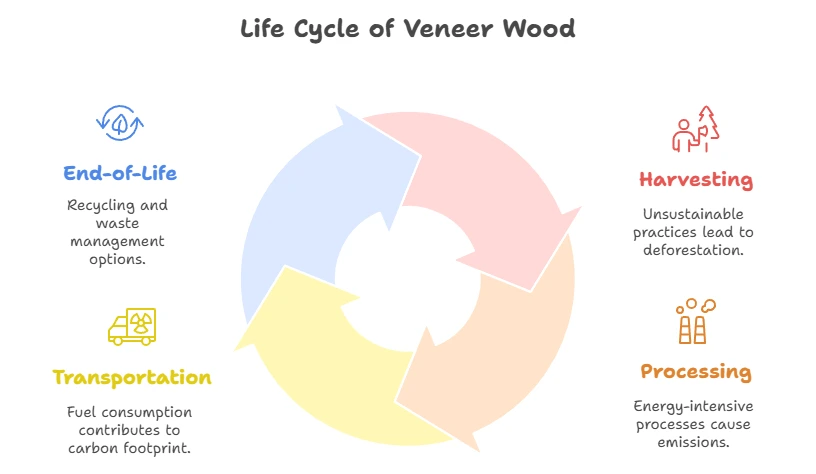
Each stage carries its own risks, but when sourced responsibly, veneer wood can be part of a sustainable ecosystem. Products made from veneer wood can be recycled or repurposed, extending their life cycle and reducing waste.
Consumer Awareness and Choices
The role of consumers is vital in the sustainability of veneer wood products. By choosing responsibly sourced veneer, you contribute to a more sustainable future. Look for certifications like FSC when making purchases. Additionally, supporting companies committed to eco-friendly practices can drive demand for sustainable products.
You might also consider alternatives to solid wood, such as reclaimed wood or engineered wood products, which utilize less wood overall. Each choice you make can impact the forests and ecosystems worldwide.
To learn more about sustainable practices in veneer production, visit organizations such as the World Wildlife Fund and the American Forests. Educating yourself on the implications of your choices can empower you to make better decisions that benefit both the environment and your needs.
Understanding the environmental impact of veneer wood production and usage is essential for fostering sustainable practices. Consumers, manufacturers, and policymakers alike bear the responsibility of ensuring that the industry evolves in a way that protects our planet.